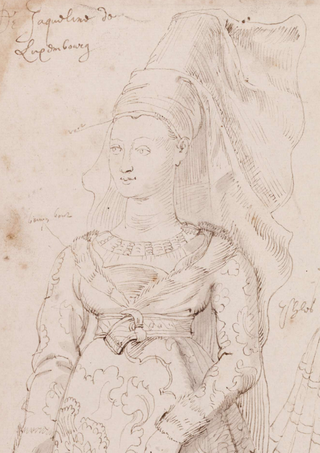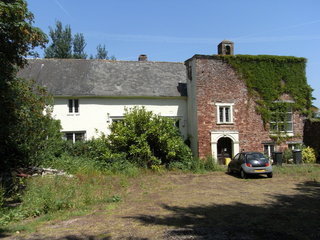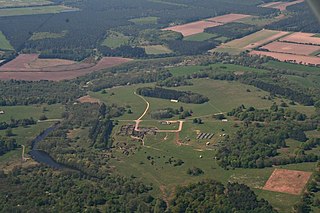
Bylaugh Hall, also known as Bylaugh Park, is a country house situated in the parish of Bylaugh in Norfolk, England.

Bylaugh Hall, also known as Bylaugh Park, is a country house situated in the parish of Bylaugh in Norfolk, England.
The estate was acquired by Sir John Lombe Bt (c. 1731–1817) in 1796. His fortune came from his family's silk throwing mill in Derbyshire; the details are uncertain. The unsubstantiated traditional story is that he won it from the former owner, Richard Lloyd, in a card game, after Lloyd's butler drugged his wine, but a more prosaic explanation seems likely.
Sir John did not marry and therefore had no legal immediate heirs. The terms of his will were complex. He left his estates to Edward Beevor (1771–1847), a barrister who was his half-brother (the product of an affair with a Norwich doctor's wife) who assumed the name of Lombe on his inheritance. [1] Sir John ordered in his will that a new mansion was to be built on his Bylaugh estate, but Edward was reluctant to do this, and the terms of this will were not fulfilled until about 30 years later when his son, also called Edward Beevor, (1800–1852) inherited the property in 1847.

Edward Beevor, who built Bylaugh Hall, also assumed the name of Lombe. He was born in 1800 in Norwich. In 1826 he became an [[Member of Parliament|MP}} for Arundel. In 1831 he married Marie Rozer de St. Julien, who was French. [2] The couple had no children and spent most of their lives travelling abroad. In 1849, after a long delay, the Court of Chancery intervened, and ordered the use of the trust funds for their appointed purpose, and the architects Charles Barry, Jr. and Robert Richardson Banks were at length commissioned to design a suitable house. William Andrews Nesfield advised on the position of the house, and was responsible for laying out the grounds and gardens. The clock tower and surrounding buildings are vaguely reminiscent of the new Houses of Parliament which were designed by Sir Charles Barry, Sr. Along with the Houses of Parliament, it was amongst the first buildings ever to employ steel girders in the supporting structure. The exterior stonework, including the balustrades and the terrace walling, are of Magnesian Limestone. At that time the estate was the third largest in Norfolk, containing over 19,000 acres (77 km2).
Bylaugh Hall was completed in 1852, but Edward had died in the same year in Florence before its completion. It was inherited by his uncle Charles Beevor (1776–1860) who assumed the name of Lombe in accordance with Sir John Lombe's will. He was the first resident of Bylaugh Hall. [3]
Charles died in 1860 and was succeeded[ clarification needed ] by Rev. Edward Evans (1791–1861) [4] who was a legitimate descendant of the Lombe family. [5] [6]

On inheriting the estate, the Rev. Edward Evans took the extra name Lombe, making his surname Evans-Lombe; but he only lived for a year, and his younger brother Rev. Henry Evans then inherited in turn. He also added Lombe to his name in 1862.
Rev Henry Evans-Lombe (1792–1878) was born in 1792 in Kirby Bedon. His father was Thomas Browne Evans (1767–1827) and his mother was Mary Hase who was the niece of Sir John Lombe. He was educated at Cambridge University and became a clergyman. In 1818 he married Sophia Cubitt, daughter of Thomas Cubitt of Honing Hall, Norfolk. The 1871 Census shows Henry and Sophia living at Bylaugh Hall with some of their family. There were also fifteen servants living in the Hall: a butler, two footmen, a housekeeper, a lady's maid, three housemaids, a scullery maid, a general domestic servant, a coachman, two grooms and two gardeners.
He died in 1878 and his son Rev. Henry Evans-Lombe (1819–1897) inherited the Hall. He was born in 1819 in Norfolk. In 1849 he married his cousin Louisa Brown Evans. The couple had five children. He lived in the Hall with his family for almost twenty years and is listed in both the 1881 and 1891 censuses with a very large number of servants. He died in 1897 and his son Major Edward Henry Evans-Lombe inherited the house. He did not live in the house but instead rented it to William Knox D'Arcy, a wealthy mining magnate, from 1899 until 1917 when D'Arcy died.
Major Edward Henry Evans-Lombe (1861-1952) was born in 1861 in Suffolk. He was also educated at Cambridge University, and joined the military forces in the Prince of Wales' Own Norfolk Artillery Militia. [7] He also managed his father's estate at Great Melton Hall. In 1886 he married Albinia Harriet Leslie-Melville, daughter of Alexander Samuel Leslie-Melville of Branston Hall, Lincoln. The couple had two daughters who were frequently mentioned in the social pages. The eldest daughter Albinia Mary Evans-Lombe was married in 1911 and a photo is shown of the couple.
In 1917 Major Edward Henry Evans-Lombe sold Bylaugh Hall and the 8,150 acre estate to speculators who promptly broke it up into lots and put it back on the market with estate agents John D Wood. The Hall and 736 acres of parkland were bought by the Marsh family.


The Marsh family, who were Americans, owned Bylaugh Hall until 1947. Henry Wheelwright Marsh (1860–1943) seems to have bought the Hall in 1917. He was one of the founders of the insurance brokerage firm Marsh and McLennan, with headquarters in Chicago and New York. In 1904 he married Agnes Elizabeth Power (1876–1947) who came from Boston, Massachusetts. The couple had no children but they loved to entertain. They made their home in England, while Henry 'commuted' to the US by steamer. Before settling at Bylaugh he had leased many notable historical buildings. These included Medmenham Abbey, Knebworth House and Warwick Castle. [8] While they still held the lease on Warwick Castle, it seems that they decided to buy their own property, and so purchased Bylaugh Hall. They continued to entertain at Warwick Castle after their purchase, and a photo of Mrs Agnes Marsh with two members of Russian royalty at one of their house parties is shown. They were separated in 1926 and Agnes made her home at Bylaugh.
Other members of Agnes' family also came to live at Bylaugh Hall for extended visits. In 1922 her sister Alice Anne Rice and her brother-in-law David Rice became residents. [9] At the same time her sister Genevieve "Viva" Power (1885–1964), who had married Dr (later Sir) Russell Wilkinson (1888–1969), moved into the Hall. A notice appeared in The Times in 1923 advertising for a nursery governess for Mrs Russell Wilkinson's two young children Derek and Diana Wilkinson at Bylaugh Hall. [10] Agnes' sister Alice died at the Hall in 1935.
During World War II the Hall was requisitioned by the Royal Air Force. Agnes Marsh moved into the "Butler's Cottage" for the duration. The 100 Group (Bomber Support) moved there in 1944, and an account of their activities is given in 100 Group (Bomber Support): RAF Bomber Command in World War II by Martin W. Bowman. [11]
Henry Wheelwright Marsh died in 1943 at the age of 86. Agnes Marsh died in 1947 at Butler’s Cottage, Bylaugh. [12]
In 1948 the house was sold to a new owner who unsuccessfully tried to turn it into a nursing home. By 1950, it was in disrepair, and in June of that year a 350 lot demolition sale was held which stripped the house of its lead roof and interior fittings, leaving it an abandoned ruin.
In 1999 the house (and a lodge) was sold to a local sculptor who dreamt of fully restoring it to its former glory.
By July 2009 the house and outbuildings were the subject of ongoing financial and legal problems that resulted in their complete repossession and the apparent loss of deposits by a number of people. [13]
In February 2013 the banks by now in possession put the unfinished house up for sale. [14]
In March 2014 the house and outbuildings were purchased by Ben Budworth, owner of The Lady Magazine published in London.[ citation needed ]

Jacquetta of Luxembourg, Dowager Duchess of Bedford and Countess Rivers was a prominent, though often overlooked, figure in the Wars of the Roses. Through her short-lived first marriage to the Duke of Bedford, brother of King Henry V, she was firmly allied to the House of Lancaster. However, following the emphatic Lancastrian defeat at the Battle of Towton, she and her second husband Richard Woodville sided closely with the House of York. Three years after the battle and the accession of Edward IV of England, Jacquetta's eldest daughter Elizabeth Woodville married him and became queen consort of England. Jacquetta bore Woodville 14 children and stood trial on charges of witchcraft, of which she was exonerated.
Robert Montagu, 3rd Earl of Manchester JP was an English courtier and politician who sat in the House of Commons from 1660 to 1671 when he inherited the peerage as Earl of Manchester.

Bawdeswell is a small rural village and civil parish in Norfolk, England. At the time of the 2011 census it had a population of 828 and an area of 487 hectares. The village is situated almost in the centre of Norfolk about 14 miles (23 km) northwest of Norwich. For the purposes of local government it falls within the Upper Wensum Ward of Breckland District Council and the Elmham and Mattishall Division of Norfolk County Council. It is on a Roman road that ran east–west between Durobrivae near modern Peterborough and Smallburgh, crossing the Fen Causeway.

Bylaugh is a civil parish in Norfolk, England 4.5 miles (7.2 km) north-east of East Dereham and 13.5 miles (21.7 km) WNW of Norwich. For the purposes of local government it falls within the Upper Wensum Ward of Breckland District Council and the Elmham and Mattishall Division of Norfolk County Council. According to the 2001 census it had a population of 65. At the 2011 census the population remained less than 100 and was included in the civil parish of Sparham.

Oxnead is a lost settlement and former civil parish, now in the parish of Brampton, in the Broadland district, in the county of Norfolk, England. It is roughly three miles south-east of Aylsham. It now consists mostly of St Michael's Church and Oxnead Hall. The hall was the principal residence of the Paston family from 1597 until the death of William Paston, 2nd Earl of Yarmouth in 1732. Under Sir William Paston (1610–1663), Oxnead was the site of several works by the architect and sculptor, Nicholas Stone, master-mason to Kings James I and Charles I. In 1931 the parish had a population of 66.

Richard Paul Jodrell was a classical scholar and playwright.
Vice admiral Sir Edward Malcolm Evans-Lombe KCB was a Royal Navy officer who became Deputy Chief of the Naval Staff.
The Bullock family traces its roots to the 12th century, living primarily in the southern English counties of Berkshire and Essex from the mid-Norman period to the late Victorian era.

Soughton Hall is a Grade II* listed country house hotel in Sychdyn, Flintshire, Wales. Notable guests that have stayed include Luciano Pavarotti, Michael Jackson and King Juan Carlos I of Spain. William John Bankes inherited Soughton Hall in the 1815.

Hoveton Hall in the parish of Hoveton in Norfolk is a Regency-style country house made of gault brick with a slate roof. It was built between 1809 and 1812, on or near the site of the previous ancient manor house of the same name, by Mrs Christabell Burroughes (1764-1843), daughter and heiress of Henry Negus (1734-1807) of Hoveton Hall, an attorney, and wife of James Burkin Burroughes (1760-1803) of Burlingham Hall, Norfolk. The architect was Humphry Repton. It is a well-preserved historic house of significance on the English Heritage Register. The Negus family had been seated at Hoveton Hall for several generations. The surrounding estate today consists of 120 acres of gardens and parkland and 450 acres of arable land as well as picturesque woodland. The gardens are open to the public during part of the year and there are facilities available for accommodation and special events including weddings.

Haughley Park House in Stowmarket, Suffolk is an historical house of significance listed in the English Heritage Register. It is a large red brick country house built in about 1620 for the Sulyard family who were very prominent landowners in this area. The property remained with this family for two centuries after which it was sold. Today it is a private residence but at certain times of the year the gardens are open for viewing. The barn and gardens are also available for weddings.

Blagdon historically in the parish of Paignton in Devon, England (today in the parish of Collaton St Mary), is a historic Manor, the seat of the Kirkham family from the 13th to 17th centuries. The manor house known as Blagdon Manor (House) (or Blagdon Barton) survives as a grade II* listed building about two miles west of the historic centre of the town of Paignton, situated behind the "Blagdon Inn" public house (former stables), and almost surrounded by the "Devon Hills Holiday Park" of caravans and mobile homes, set-back at the end of a short driveway off the A385 Paignton to Totnes road. The settlements or farms of Higher Blagdon, Middle Blagdon and Lower Blagdon are situated to the north of the manor house.

Longe is a surname of Anglo-Norman origin. The name Longe derives from the Anglo-Norman French ‘Lung’ or ‘Lang’ for tall or high. The family descend from the noble family of de Préaux who were barons in Préaux, Roumois and Darnétal, Normandy. Variants of the name include: le Long, de Long, Le Lung, Longe, Long and Longue. The family are believed to have arrived in England following the Norman Conquest and during the early 13th century divided into two branches, the Wiltshire branch and the Norfolk branch. In the Hundred Rolls of 1273, early variations have been found including, Henry le Longe in Buckinghamshire, John le Longe in Huntingdonshire; and Walter le Longe in Shropshire.

Bayfield Hall is a Grade II* listed building which stands in a small estate close to the village of Letheringsett and the hamlet of Glandford in the English county of Norfolk within the United Kingdom. The house that stands today was built in the last part of the 18 century replacing an earlier manor house thought to have been built in the 16 century. That house had been constructed of an early medieval manor house.
John Hopton was an English landowner and administrator with estates in Suffolk and Yorkshire who was active in local government during the reigns of King Henry VI and King Edward IV.
Sir John Russell, of Strensham in Worcestershire where he held the manor and advowson, was an English landowner, soldier, administrator, courtier and politician.

Lieutenant-colonel Sir Jacob Henry Astley, 5th Baronet was an English landowner and Member of Parliament.

Buckenham Tofts is a former civil parish, now in the parish of Stanford, in the Breckland district, in the county of Norfolk, England, situated about 7 miles north of Thetford, and since 1942 situated within the Stanford Training Area, a 30,000-acre military training ground closed to the public. It was situated about one mile south of the small village of Langford, with its Church of St Andrew, and about one mile west of Stanford, with its All Saints' Church and one mile north of West Tofts, with its Church of St Mary, all deserted and demolished villages. None of these settlements are shown on modern maps but are simply replaced by "Danger Area" in red capital letters. In 1931 the parish had a population of 60. On 1 April 1935 the parish was abolished and merged with Stanford.

Henry Wheelwright Marsh was an American insurance executive who co-founded the insurance brokerage firm Burroughs, Marsh & McLennan, which later became Marsh & McLennan.
Sir Edward Christopher Evans-Lombe was a British High Court judge and landowner.
![]() Media related to Bylaugh Hall at Wikimedia Commons
Media related to Bylaugh Hall at Wikimedia Commons